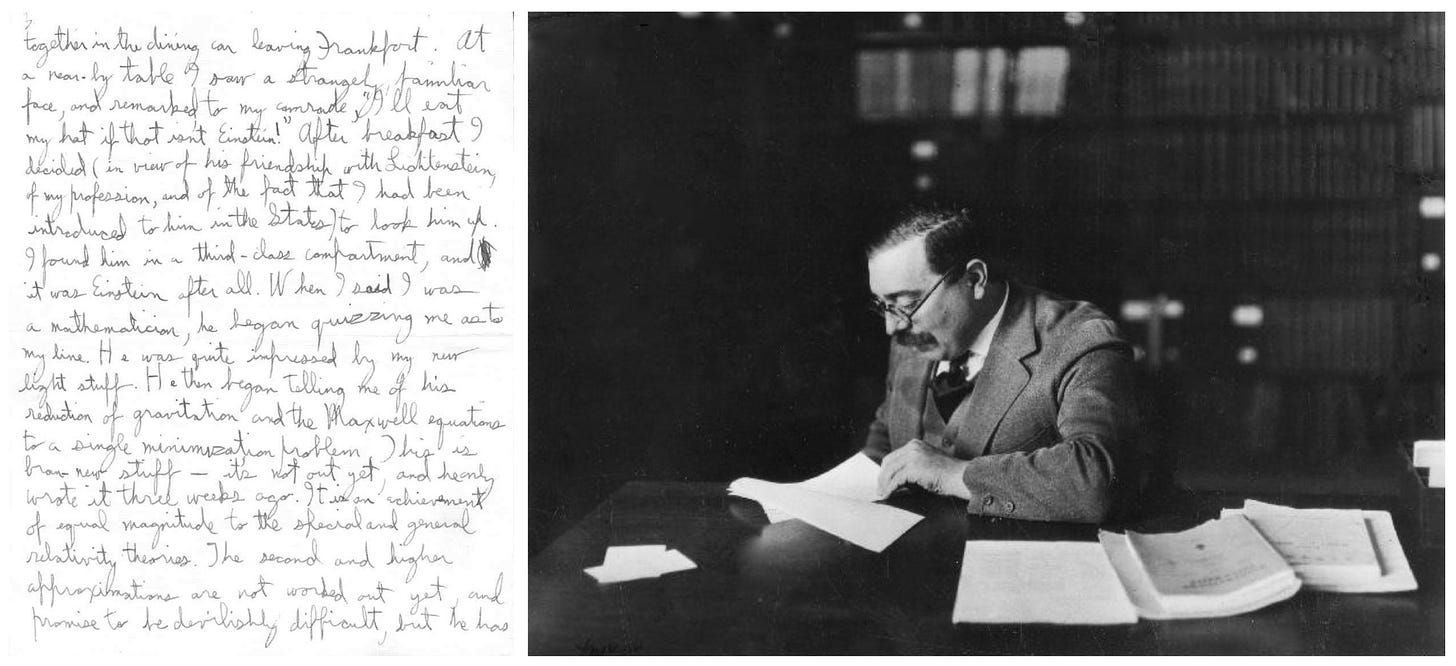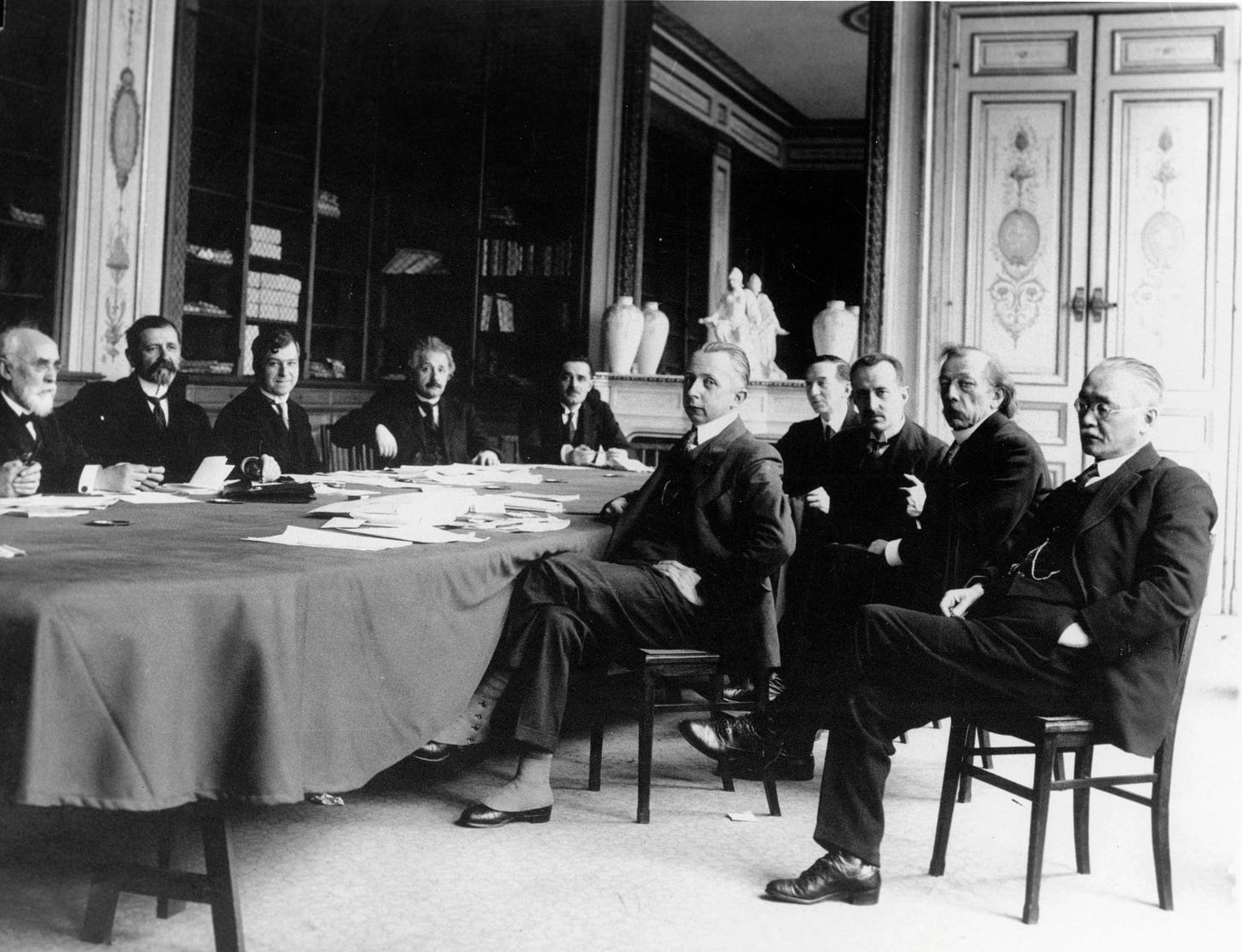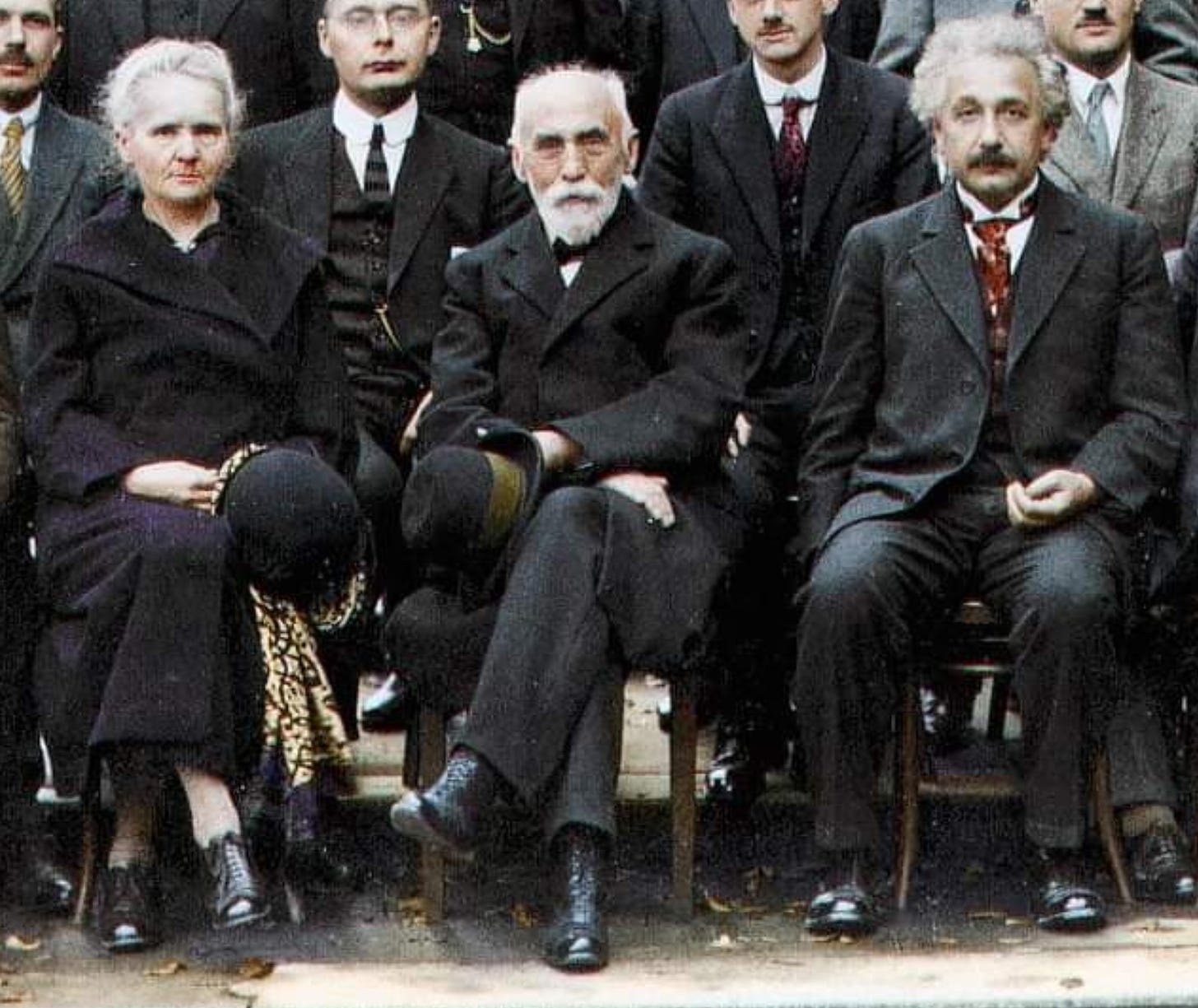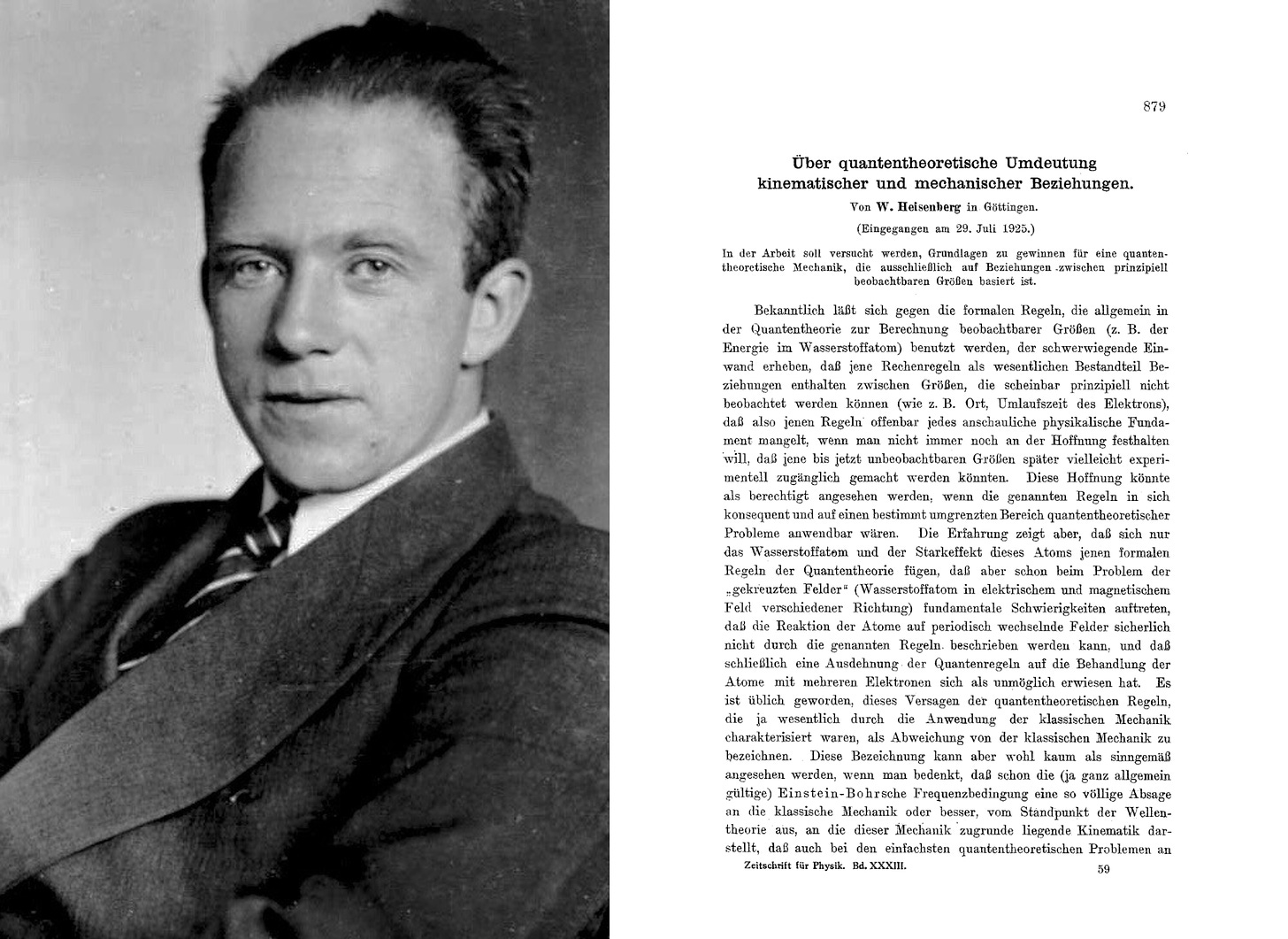When Wiener met Einstein (1925)
Mathematician and later father of cybernetics Norbert Wiener (1894-1964) crossed paths with many great minds in his life, from Bertrand Russell and G.H. Hardy, to Max Born, John F. Nash Jr. and John von Neumann.

Mathematician and later father of cybernetics Norbert Wiener (1894-1964) crossed paths with many great minds in his life, from Bertrand Russell and G.H. Hardy, to Max Born, John F. Nash Jr. and John von Neumann. von Neumann’s assistant Edgar R. Lorch’s recollection of one of his boss’ encounters with Wiener bears repeating:
“I met [von Neumann] recently at a party. The high point of the evening was a recitation race between him and Norbert Wiener. Somehow, someone recited a line from Lewis Carroll’s “The Hunting of the Snark”. Norbert Wiener with his usual ebullience and sonorous voice, began reciting from line one. Johnny started off in pursuit. Norbert accelerated, but Johnny came up even. We held our breaths as the lines poured out, on and on until they reached the end in a dead heat”
Although it is not uncommon for great scientific minds’ paths to cross, even at the time, Wiener’s encounters are somewhat unique in that he documented and reflected over many of them in various letters, memoirs and books. As recounted in a previous issue of the newsletter, his first meetings and impressions of Russell are documented in correspondences with his father Leo.
This issue narrates Wiener’s chance encounter with Albert Einstein in his own words as written to his sister Bertha in 1925. At the time of his writing of the letter Wiener was on one of his frequent trips around Europe, traveling from Leipzig to Geneva. Wiener had been spending his summer at Göttingen University for the second year in a row.
Encouraged by G.H. Hardy to read Einstein’s annus mirabilis (“miracle year”) papers eleven years earlier, Wiener had been especially inspired by Einstein’s 1905 paper on Brownian motion. His fascination with the concept of random walks would later culminate in Wiener’s extension of Einstein’s formulation of Brownian motion to establish a link between the Lebesgue measure and statistical mechanics. That is, Wiener provided the mathematical formulation for describing the one-dimensional curves left behind by Brownian processes. His work, now often referred to as the Wiener process in his honor, was published in a series of papers developed in the period 1920–24:
- Wiener, N. (1920). “The Mean of a Functional of Arbitrary Elements”. Annals of Mathematics 22 (2), pp. 66–72.
- Wiener, N. (1921). “The Average of an Analytic Functional”. Proceedings of the National Academy of Sciences 7 (9), pp. 253–260.
- Wiener, N. (1921). “The Average of an Analytic Functional and the Brownian Movement”. Proceedings of the National Academy of Sciences 7 (10), pp. 294–298.
- Wiener, N. (1923). “Differential Space”. Journal of Mathematics and Physics 2, pp. 131–174.
- Wiener, N. (1924). “The Average Value of a Functional”. Proceedings of the London Mathematical Society 22, pp. 454–467.
Wiener’s Letter
Wiener’s encounter with Einstein is documented in a twelve-page handwritten letter to his sister Bertha, sent on July 27th 1925 from Grenoble. The letter is available in its entirety through Archive.org’s WayBack Machine here.

Letter from Norbert to Bertha Wiener (July, 1925)There was a nice Swiss student from the Dresdner Technische Hochschule on the train from Leipzig. He talked very good English, and we had an animated conversation in both languages. We breakfasted together in the dining car leaving Frankfurt. At a nearby table I saw a strangely familiar face, and remarked to my comrade "I'll eat my hat if that isn't Einstein!"After breakfast I decided (in view of his friendship with Lichtenstein, of my profession, and of the fact that I had been introduced to him in the States) to look him up.
The Leon Lichtenstein (1878–1933) Wiener mentions was a Polish-German mathematician who worked in the areas of differential equations, conformal mapping and potential theory. He was the cousin of Norbert’s father Leo and obtained one of his three doctorates at Friedrich Wilhelm (later Humbolt) University of Berlin, where Einstein was appointed professor in 1914.
I found him in a third-class compartment, and it was Einstein after all. When I said I was a mathematician, he began quizzing me about my line. He was quite impressed by my new light stuff. He then began telling me of his reduction of gravitation and the Maxwell equations to a single minimization problem. This is brand new stuff -- its not out yet, and he only wrote it three weeks ago. It is an achievement of equal magnitude to the special and general relativity theories. The second and higher order approximations are not worked out yet, and promise to be devilishly difficult, but he has rather. vague hope that they may contain the secret of the electron and of quantum theory he hasn't done anything definite in this direction, however.
Wiener’s “new light stuff” likely refers to Wiener’s work on the rigorous mathematical basis for the theory of the coherence of light, eventually published in his epic work:
- Wiener, N. (1930). Generalized Harmonic Analysis. Acta Mathematica 55, pp. 117-258.
By 1925, Einstein was a Nobel laureate, having been awarded the 1921 Nobel Prize in Physics for "for his services to theoretical physics, and especially for his discovery of the law of the photoelectric effect". His “debate of the century” with Niels Bohr over quantum mechanics had not yet taken place, as it is generally said to have begun during the Fifth Solvay International Conference on Photons and Electrons in 1927.
I retired after about half an hour, as I didn't want to bother the poor guy, who must be rushed to death with fools who take up his time. At Basel, however, I saw him getting off the train. It turned out that we were both bound for Geneva. I had to get a ticket. He told me to look for him on the train, or at any rate seemed to show a desire for my further company. While I was going third class, he was going second. He explained that he was attending a meeting of the League of Nations committee for scientific collaboration at Geneva, and, as he said naively, he wanted to make a good impression on them when he got off the train.

Albert Einstein had in 1922 been invited to join the International Committee on Intellectual Cooperation (CICI) of the League of Nations, the body created to promote international exchange and cooperation between scientists, researchers, teachers, artists and intellectuals. Wuthin a year, he had resigned in protest over the re-occupation of the Ruhr by the French army. A pacifist, he was distressed over the League’s impotence, but would still return about a year later and go on to serve as one of its delegates from Germany until 1932.
He moved into the third class compartment with me, however, and would not hear my moving to second. From Basel to Geneva we had about five and a half hours of steady conversation on all imaginable topics -- and I didn't force myself on him, either. He spoke of the League of Nations committee, said that it didn't amount to a thinker's damm, but that to drop it would be an awfully bad step. He said that five hours of discussion bored him to extinction, but that it was worthwhile to meet Madame Curie, Hardy (I think) and the other eminent scientists.
Both two-time Nobel Laureate Marie Curie (1867-1934) and Einstein’s former physics professor / Nobel Laureate Hendrik Lorentz (1853–1928) were also members. When later asked which physicist Einstein respected the most, he replied with the names of both. Regarding his admiration for Curie, he stated: “I have always admired […] Marie Curie. Not only did she do outstanding work in her lifetime and not only did she help humanity greatly by her work, but she invested all of her work with the highest moral quality. All of this she accomplished with great strength, objectivity and judgement. It is very rare to find all of these qualities in one individual. In fact, if more European intellectuals had had Madame Curie’s modesty, conditions might have been much brighter” (Pycior, S.W., 1999). On account of their personal relationship, the two were photographed together on numerous occasions. In the following photograph, sometimes referred to as the “most intelligent photograph ever taken”, the two are seated alongside Einstein’s other hero, Hendrik Lorentz.

As far as I can surmise, Hardy was never a member of the League, so (as he writes) Wiener must have misunderstood Einstein. The letter continues:
He was rather pessimistic about the prospect of scientific rapprochement in Europe -- said that the Germans had been to long excluded that they were getting out of hand for. He felt, however, that international rapprochement or another world war were the only things likely to happen. He did not agree with Russell that another world war would mean the end of civilization. He thought the leadership of civilization would pass to America and ultimately to Asia. He thinks that our general education level in the States is poor, but that there are great centers of learning with us and that much fine work is being done. He expects big things from the U.S.
Indeed, ominous for Einstein to predict that the leadership of civilization would pass to America and ultimately Asia. Einstein‘s admiration for the United States appears to have begun in 1921, when he visited New York City for the first time. As he then wrote in an essay entitled ‘My First Impression of the U.S.A.’, he was surprised to find that “What strikes a visitor is the joyous, positive attitude to life […] The American is friendly, self-confident, optimistic, and without envy” (Holton, 1996). Famously, he later would emigrate to the U.S. to join the permanent faculty of the newly founded Institute for Advanced Study about seven and a half years after his meeting with Wiener.
He is much interested in the Russian situation, is sympathetic with socialism, but is disgusted with the bigotry and the espionage system of the Bolsheviks. He has lived much in Switzerland and is very fond of the Swiss. He prefers their free spirit to the rigid German. He is most non-conformist (umbanzenhaft), but says that it in a conformist (banzenhaft) environment (note: a Banze is a German Professor of the Münsterberg type). He finds it is necessary for him to protect his time from unwarranted intrusions. He has travelled all over the world of late years, but is going to cut down on this to get more time to work.
During the Nazi-led propaganda campaign against Jewish intellectuals, Einstein was often criticized for his support of the Soviet Union and socialist ideals. This later became the topic of a 2001 book by Alexander Vucinich entitled ‘Einstein and Soviet Ideology’. The FBI would create a secret dossier on Einstein in 1932, which by the time of his death was 1,427 pages long.
He regrets the existence of extreme nationalism in Germany, but asserts that there is such a thing. At the same time he was rather shocked when I told him of the revenge poems I had seen framed in inns and for sale at stationaries. He is not anti-French. As sane and sober-minded a man as I have ever met.
Einstein succinctly surmised his opinion of nationalism in the statement “Nationalism: An infantile disease. It is the measles of mankind”. Even three years prior to his meeting with Wiener, he wrote sister Maja warning of the dangers of the growing nationalism and anti-semitism. His eventual emigration to America occurred in 1932 after a German magazine printed a list of “enemies of the German regime” with an accompanying picture marked “not yet hanged” with a $5,000 bounty for his head (Jerome & Taylor, 2006).
He talked with me even of the possibilities for integral equation methods in relativity and asked me many questions. He was much struck with Phil's definition of potential functions. He told me of some work of his own which was closely related to some stuff of Rado's on minimal surfaces, which I had heard a student present in L's seminar in Leipzig, and which isn't out yet. He explained me his point of view on Civita's parallel transformation theory.
The “Phil” Wiener is referring to is likely Philip Franklin (1898-1965), an American mathematician and later colleague of Wiener at MIT who was married to Wiener’s other sister Constanance. Tibor Radó (1895–1965) was a Hungarian mathematician who proved that surfaces have an essentially unique triangulation, but is most well known for his solution to Plateau’s Problem. Tullio Levi-Civita (1873–1941) was an Italian mathematician most well known for his work on tensor calculus and its applications in Einstein’s theory of relativity. Levi-Civita and Einstein were friends and the former even travelled to Princeton and lived with Einstein for a year in 1933. Once, when asked what he liked best about Italy, Einstein is said to have replied “spaghetti and Levi-Civita” (Allyn, 1996).
He cleared up in my mind another problem, that of the statistical meaning of the second law of thermodynamics, by explaining that the world as a whole is not near a position of statistical equilibrium, but has a definite trend, as if there had been a creation. He said that Planck's treatment of this matter is wholly wrong, and that he considers a right understanding of the subject more difficult than a right understanding relativity theory.
Max Planck (1858-1947)’s Treatise on Thermodynamics* was published in 1897. Although considered the originator of quantum theory, by 1925 Planck was 67 years old and set to retire. He was succeeded by Erwin Schrödinger (1887-1961) the following year.
He considers the present confused state of science to be temporary, and due to the lack of leading ideas. He deplores the flooding of the literature by immature, idea-less papers, and sticks up for form in presentation. Of this he is a master.He has an intense love for the beauties of nature --was continually pointing out to be cloud-- effects over the lakes of Biel and Neufchatel. He likes the quieter parts of Switzerland, such as the Jura. He is very fond of woods and scenery like our New England scenery. He is much interested in engineering, he worked seven years in the Swiss patent office. The new electric locomotives excited his intense curiosity.
Einstein and Wiener travelled by train from Leipzig to Geneva, a 731 kilometer ride which goes through both Frankfurt and Basel. Biel and Neufchatel are both towns in Switzerland. Jura is the most northwestern canton of Switzerland, bordering the French regions of Bourgogne-Franche-Comte and Grand Est to the west and north, respectively. Electrification of the European railway was initially focused on mountainous regions (such as Switzerland) for several reasons: the logistics of supplying coal was difficult, hydroelectric power was readily available and electric locomotives gave more traction for inclines. Einstein’s own later forays into engineering included patents for refrigerators, electromagnetic pumps, sound reproduction apparatus and light intensity self-adjusting cameras.
Personally he is simple, direct, unaffected and rather winning. His enormous intellectual energy, his clean vision and sense of physical reality, and his enthusiasm strike the most casual observer.He is aware of his great position, but not in the least conceited. He does not expect relativity in its present form to last many decades, and hope that further work will soon go beyond it. As to quantum theory, in which he has a large share, he is most dissatisfied. He judges other scientists charitably and not by an excessively large footnote. He expects somebody to make a big killing in the none too distant future by cleaning up the theory of radiation in quantum theory.
Einstein’s Nobel had been awarded especially for his work on the photoelectric effect, in which he proposed the idea of energy quanta, light particles now called photons. The paper is discussed in detail in the following issue of Privatdozent:
- Einstein’s 1905 paper on the Photoelectric Effect, (July 16th 2021)
The paper had been inspired by Max Planck’s earlier derivation of Planck’s law of black body radiation (for which Planck was awarded the 1918 Nobel Prize in Physics). Within weeks of Wiener and Einstein sitting on the train, 26-year old Werner Heisenberg (1901-76) sent his breakthrough paper Über quantentheoretische Umdeutung kinematischer und mechanischer Beziehungen (“Quantum theoretical re-interpretation of kinematic and mechanical relations” to Max Born to review and decide whether it should be submitted for publication. It was in August, and the paper which laid the foundation for matrix mechanics, the first conceptually autonomous and logically consistent formulation of quantum mechanics was established.

Please don't think I forced myself on him. I was respectful, but didn't treat him like the Lord God Almighty, because I should imagine he would be rather sick of that sort of treatment by now. We left on the best of terms. I thanked him for the opportunity he had given me and he faroh-farohed it, and spoke of our conversation as "ganze nett". We talked German, of course, as he has no English (although he has French, Italian, and some Spanish).
[...]
Your loving brother,
Norbert.
Later in the summer, Wiener would lecture on his work to the assembled group of mathematicians at Göttingen, both faculty and visiting, later writing home that Hilbert had described his work as sehr schön (“very beautiful”). Towards the end of the stay, the head of the mathematics department, Richard Courant (1888–1972), reportedly told him that if he came back the following year he would be given the position of visiting professor. He did so in 1926 as a Guggenheim scholar.
References
- Allyn, J. (1996). "Celebrating the 100th Annual Meeting of the AMS". In Case, Bettye Anne (ed.). A Century of Mathematical Meetings. Providence, RI: American Mathematical Society. pp. 10–18.
- Holton, G. (1996). Einstein, History, and Other Passions. Cambridge: Harvard University Press.
- Jerome, F. & Taylor, R. (2006). Einstein on Race and Racism. Rutgers University Press, p. 10.
- Pycior, S.W. (1999). Marie Skladowska Curie and Albert Einstein: A Professional and Personal Relationship. The Polish Review Vol. XLIV, No. 2, pp. 131-142.
* Amazon affiliate links





